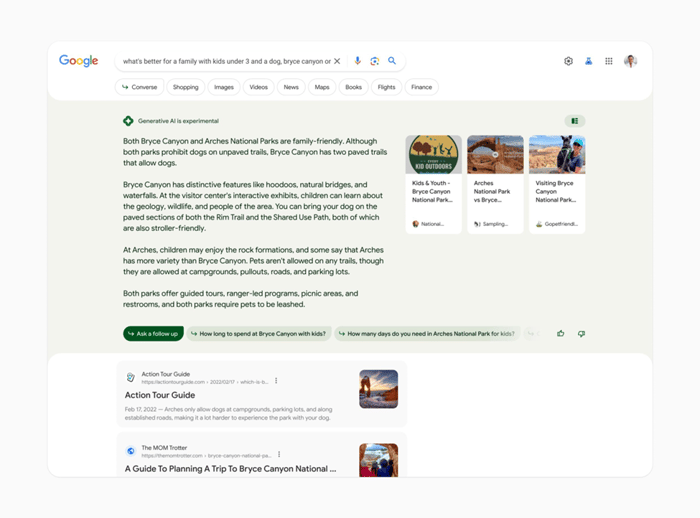Well, we’re halfway home. Right now, it feels like the eye of the hurricane, with GivingTuesday behind us and Dec. 31 ahead.
As you wait to find out how well your year-end fundraising plans turn out, we’ve got a new batch of digital news for you. We’ll start with three updates from Google as the tech giant is looking to start 2024 with a bang.
Google’s third-party cookie closeout starts in Q1 2024
Google’s plan to deprecate third-party cookies by the end of 2024 is on as scheduled, according to Dan Taylor, Google’s VP of Global Advertising.
The party starts in Q1 as 1% of Chrome users will see third-party cookies turned off. That may not seem like much, but 1% of 3 billion monthly global users is still 30 million people.
Google is planning this phased rollout to help ensure developers are ready for the changes. But make no mistake: These cookies will be gone by the end of next year.
Start preparing now by setting up proper measurement of your first-party data so you will be able to leverage these insights when the time arrives. Charles Lehosit, RKD’s VP of Technology, has written a great overview of how to measure online behavior.
Google is deleting old Gmail accounts
Google recently announced plans to begin deleting old, unused Gmail accounts. And it appears that the purge has begun, as of Dec. 1.
For nonprofit organizations, this means you may see additional hard bounces on your email deliveries in the coming weeks.
December is often a good time to reflect on the past year, and January is when you begin to implement new plans and ideas. That makes this a great moment to focus on email hygiene.
We recommend noting these bounces and deleting the addresses from your email list. Your mailing list will shrink, but this should improve your open and click rates.
While you’re at it, take note of those email addresses that haven’t responded at year-end. Maybe it’s time to put them on the shelf for appeals or move them into a lapsed-recapture segment.
How SGE could affect your website traffic
Google’s AI-driven Search Generative Experience (SGE) debuted a few months ago in an experimental phase. So far, the reception has been poor—with many people noting that SGE is “way too slow”—but the tech giant is ready to roll it out fully in 2024.

SGE acts more like a chatbot, providing answers to queries in more of a conversational style. It summarizes the search results into several paragraphs of copy at the top of the results page.
While Google is unlikely to mess too much with its paid search cash cow, we’ll likely see organic search results get pushed farther down the page. Keep a close eye on your organic traffic in the coming weeks and months to note if there are any sudden drops.
Facebook deposit changes and advice
Starting Nov. 1, Meta announced a move to PayPal Giving Fund to process payments on Facebook/Meta Fundraisers. They also noted that Meta will no longer cover processing fees on donations.
We’ve heard from a few clients who have had issues with this new payment setup, so be on alert if you’re using Facebook’s fundraising capabilities.
Facebook/Meta Fundraisers can be potent tools, but they have limited options for fundraising. We recommend advertising on Facebook, but you should be pushing users to your donation page where you have more control over the look and feel of the experience.
Trouble at X continues
Another month, another report of bad news at X (formerly Twitter).
Walmart has become the latest big spender to jump ship, just two days after Elon Musk publicly stated that advertisers who left can “go f___ yourself.” In recent months, Disney, IBM, NBCUniversal and Comcast have all decided to end their advertising relationships with X.
In the meantime, Meta’s Threads has started to pick up some steam after a late-summer lull. Since September, Threads has 41 million new downloads in the App Store and Google Play, compared to 27 million new downloads for X.
Still, Threads has a long way to go. X still has over 500 million monthly users, compared to just under 100 million for Threads, as of October.
QR code tip: What’s in a name?
Finally, let’s talk briefly about QR codes. More specifically, QR code phishing—aka, quishing.
Thanks largely to restaurants, QR codes soared in popularity during the pandemic. We often scan them with our phones without giving a thought to how secure they may be. Well, a new trend in cybercrime is emerging as attackers are using malicious QR codes to hack into users’ phones.
If your organization is using QR codes for fundraising, there’s one thing you can do to help users feel more secure: Put your website address directly into the preview instead of using bit.ly or other URL shortening tools. This lets users know exactly where the link will send them, whereas a bit.ly link could redirect to a malicious address.






Leave a comment: